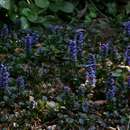en
names in breadcrumbs


Ajuga /əˈdʒuːɡə/,[4] also known as bugleweed,[5] ground pine,[6] carpet bugle, or just bugle, is a genus of flowering plants in the Ajugeae tribe of the mint family Lamiaceae. There are over 60 species[7] of annual or perennial, mostly herbaceous plants.[8] They are native to Europe, Asia, Africa, and Australia.[7]
They grow to 5–50 cm (2-20 in) tall, with opposite leaves.[9]
Species accepted within Ajuga include:[3]
 Ajuga on fine gravel
Ajuga on fine gravel Ajuga /əˈdʒuːɡə/, also known as bugleweed, ground pine, carpet bugle, or just bugle, is a genus of flowering plants in the Ajugeae tribe of the mint family Lamiaceae. There are over 60 species of annual or perennial, mostly herbaceous plants. They are native to Europe, Asia, Africa, and Australia.
They grow to 5–50 cm (2-20 in) tall, with opposite leaves.